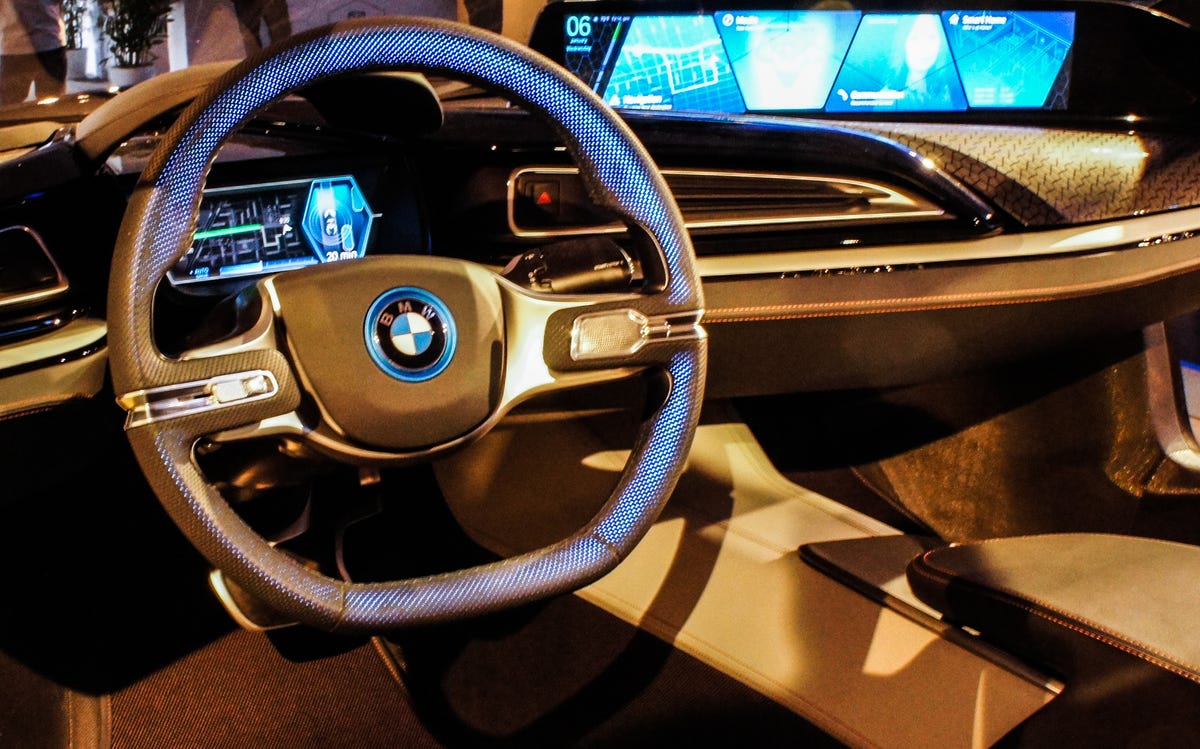
BMW i Vision Future Interaction
BMW's CES concept uses gesture sensors to control infotainment features, eliminating buttons and dials from the console and dashboard.
Visteon gesture control concept
Automotive supplier Visteon also has a gesture control concept, which could be deployed in cars soon.
Rinspeed Etos dashboard
The Rinspeed Etos dashboard has two modes, driving and autonomous. In autonomous, the steering wheel folds up and conceals itself in the dashboard.
Visteon 3D instrument cluster
Visteon's 3D display technology uses two LCDs to show very realistic-looking graphics.
Visteon 3D instrument cluster
At the touch of a button, you can completely change the look of the Visteon display.
Visteon OLED infotainment concept
Visteon is also working on OLED display technology, using smart power control to avoid burn-in, a problem with OLEDs.
Mercedes-Benz E-Class dashboard
Mercedes-Benz showed off the dashboard software and touch controls for its new E-Class model ahead of its introduction next week in Detroit.
Jeep dashboard concept
Jeep's digital dashboard uses three wide LCDs and includes personalization features.
Jeep dashboard concept
The Jeep setup is constructed on a base of wood and natural materials, meant to evoke the outdoorsy nature of the brand.
Kia Nomos concept dashboard
Kia's Nomos concept cockpit is, you guessed it, designed to work with autonomous and semi-autonomous driving features.
Kia Nomos concept dashboard
Nomos features a fingerprint scanner to start the car and access in-car payment for tolls and fuel. A heads-up display (simulated here) give information about other vehicles, pedestrian detection and more.
Denso Multi Area Controller
Denso showcased a concept dashboard that uses eye-tracking to detect what part of the interface the driver is looking at (navigation, infotainment, climate, etc.) and assigns control to that function.
Pioneer ADAS demonstrator
Pioneer's advanced driver aid system demonstrator rolls in an array of semi-autonomous aids. There's a laser head-up display, driver recognition and a fragrance feedback system that can suggest scents to keep the driver alert or calm.
Pioneer ADAS demonstrator
The seat of the Pioneer demonstrator features biometric sensors that can monitor the driver. Speakers integrated into the headrests provide directional alerts for blind spot monitoring and more.
Hyundai autonomous cockpit
We swung by Hyundai's booth to preview its autonomous driving cockpit.
Hyundai autonomous cockpit
The cockpit features a long strip display that integrates side camera feeds. When in its autonomous mode, the seat leans back and the rear mirror becomes a video screen for watching content.
Hyundai autonomous cockpit
Hyundai's system features a lot of predictive information that can automatically suggest destinations and deep integration with communications.
QNX digital instrument cluster
In its demonstrator Toyota Highlander, QNX showcased a concept digital instrument cluster that ties in with infotainment and driver aid functions. We've seen similar concepts and implementations before.
QNX digital instrument cluster
However, the QNX system is the first time that I've seen Android Auto in the instrument cluster.
Garmin Lenexa concept dashboard
With the Lenexa concept dashboard, Garmin seeks to move away from a vision-based touchscreen interface and back to a tactile dashboard based around knobs.
Garmin Lenexa concept dashboard
The interface is designed to be used without looking (like volume knobs), but there are screens integrated into the dashboard that can display information.
Mercedes-Benz E-Class preview
Mercedes gives us a look at the immediate future with a preview of the upcoming E-Class sedan's digital dashboard.
JVC-Kenwood ADAS components
Showcased near its McLaren 675LT concept, JVC-Kenwood displayed the various prototype driver aid components, including camera-based side and rear mirrors, heads-up display components and more.



